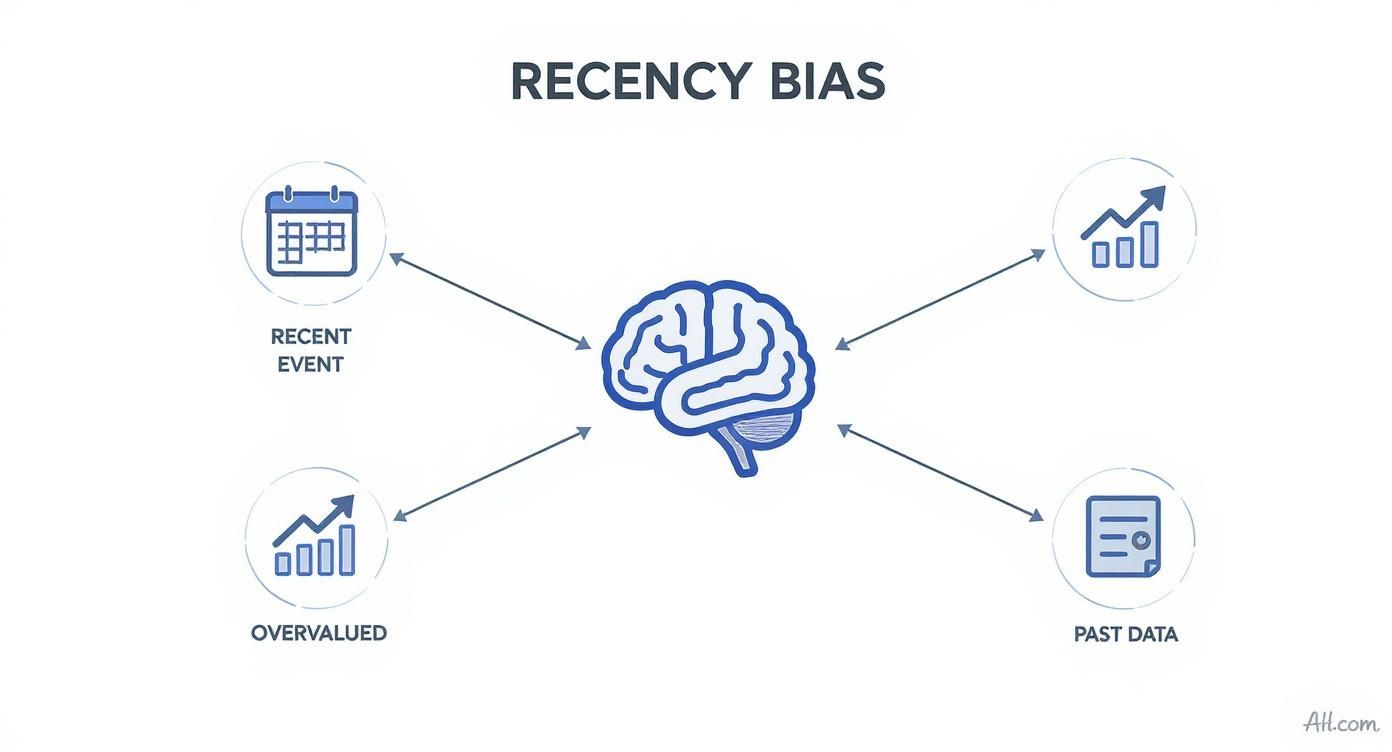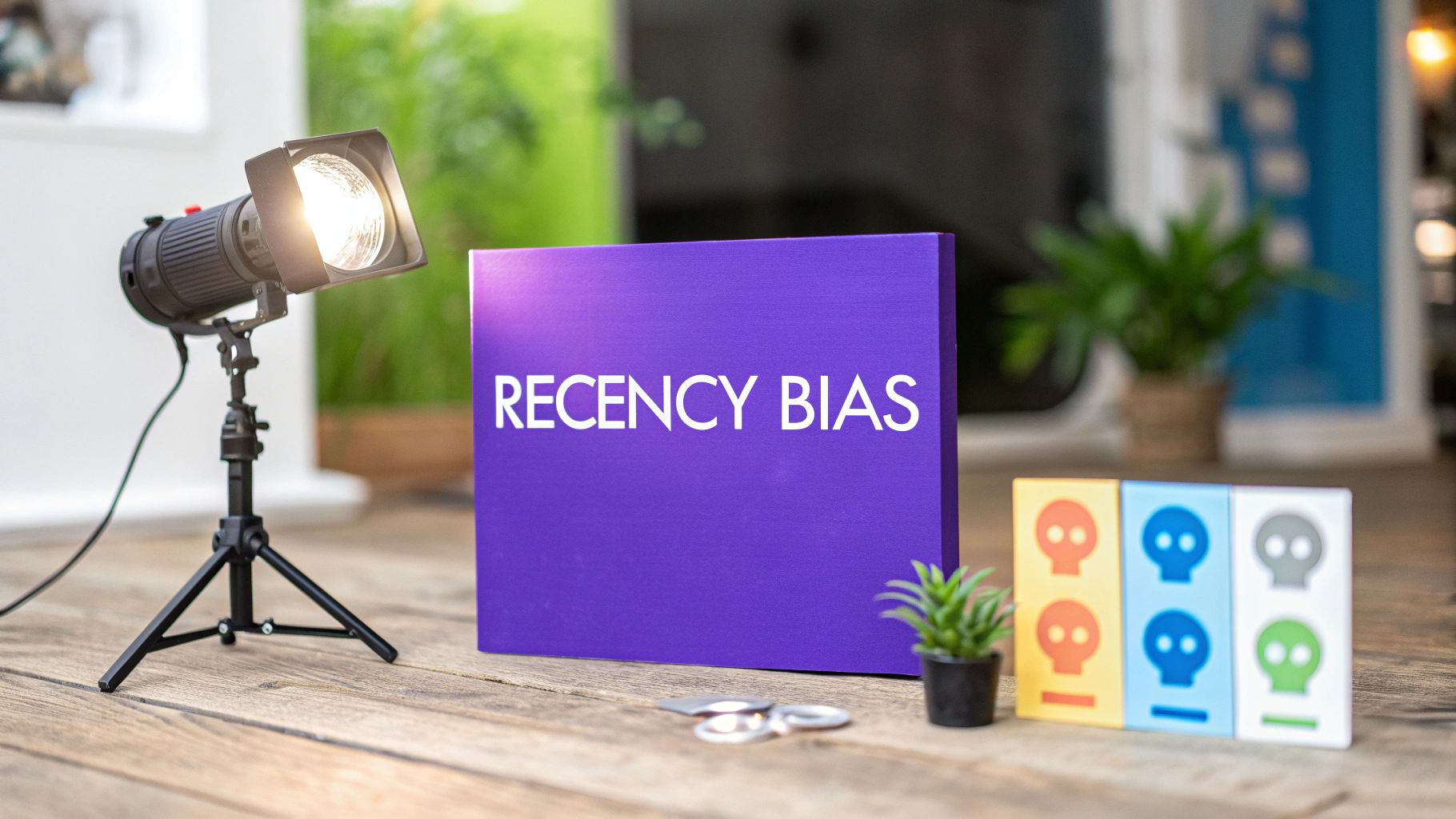Here's a simple truth: Recency bias is the mental shortcut that makes us believe what just happened is more important than what happened in the past.
Think of it like this: you watch a fantastic two-hour movie, but the final five minutes are a total letdown. If you walk out of the theater only talking about the bad ending, ignoring the brilliant 115 minutes that came before it, that's recency bias in action.
Understanding Recency Bias Through Simple Examples
We see this cognitive hiccup play out all the time. A sports commentator might demand a star player be benched after one bad game, seemingly forgetting their season of MVP-worthy performances. Or an investor panics and sells off their stocks during a brief market dip, completely ignoring years of steady, reliable growth.
That's recency bias. It’s a natural human tendency to give more weight to the freshest information we have.
Our brains are wired this way for a reason. Psychologically, it’s a type of survival mechanism; our minds are designed to focus on what’s happening right now because it often feels like the most relevant information for immediate threats or opportunities. While helpful in some situations, this short-term focus can lead to seriously flawed logic when making bigger, more complex decisions. You can learn more about the psychological roots of this bias and its effects.
The Spotlight Effect of Recent Events
Imagine your memory is a long hallway lined with filing cabinets, one for each month of the year. Recency bias acts like a powerful spotlight that only shines on the cabinet right in front of you—the most recent one. The other eleven cabinets, full of equally valuable data, are left in the shadows.
This "spotlight effect" means that when it’s time to make a call, we instinctively pull from the file that’s most brightly lit and easiest to reach. It’s a handy mental shortcut, for sure, but it becomes a major blind spot when historical context is the key to making a truly informed judgment.
The image below gives a great visual of how our brains tend to put recent events on a pedestal.

As you can see, the brain gives an inflated value to what just happened, pushing older—but equally relevant—data into the background. This imbalance is exactly what makes recency bias so tricky to spot and overcome.
To make it even clearer, here’s a quick summary of what we’re talking about.
Recency Bias at a Glance
| What Recency Bias Is | What Recency Bias Is Not |
|---|---|
| A cognitive shortcut that overemphasizes recent information. | A deliberate choice to ignore past data. |
| An unconscious, automatic response to new stimuli. | A sign of poor memory or lack of intelligence. |
| Judging a situation based on the latest event. | A comprehensive analysis of all available information. |
| Reacting emotionally to short-term fluctuations. | A strategic, long-term perspective. |
Ultimately, recency bias isn't about being forgetful; it's about how our brains naturally—and often incorrectly—prioritize information.
How Recency Bias Shows Up in the Real World
To really get a handle on recency bias, you have to see it in action. This isn't some dusty concept from a psychology textbook; it’s a mental shortcut that quietly steers major decisions everywhere—from Wall Street to the sports arena to your own office. Let's look at a couple of clear examples of this bias at play.

The Panicked Investor
Picture an investor named Sarah. For a decade, her diverse portfolio has been chugging along, delivering steady, healthy returns. Then, out of nowhere, the market takes a nosedive for one month. Every headline is screaming doom and gloom, and her portfolio value drops.
Suddenly, those 10 years of solid growth are ancient history. All Sarah can see is the recent dip, which feels way more important and predictive than the entire successful run she’s had. She panics and sells off a huge chunk of her investments at a loss, all because of the immediate fear of what might happen next. That’s a textbook case of recency bias twisting financial judgment.
This isn't just a one-off story. Studies in behavioral finance have found that over 60% of retail investors are swayed by recency bias, often causing them to chase hot trends or sell in a panic. Think back to the financial crisis in the late 2000s—investors who sold at the bottom because of the scary headlines missed out on the massive market rebound that followed.
The Overreacting Sports Analyst
Now, let's switch gears to sports. Imagine a star quarterback who has been a top performer all season, leading his team to win after win. He has a whole career filled with amazing plays. But in the last two games right before the playoffs, he completely fumbles, throwing interception after interception.
All of a sudden, sports analysts and fans are calling for him to be benched. His entire career of excellence is forgotten, overshadowed by just a couple of bad games. The most recent information—those two poor performances—becomes the only thing anyone can focus on, completely ignoring the massive, more reliable sample size of his long and successful career.
Key Takeaway: Recency bias is like looking at the world through a fisheye lens. It blows recent events way out of proportion, making them seem much more significant than they really are. It shrinks our perspective, causing us to overreact to short-term blips while ignoring the long-term story.
This is just one of many mental shortcuts that can throw off our judgment. Getting familiar with the different types of cognitive bias in decision-making is the first step toward making clearer, more thoughtful choices. Once you can spot these patterns, you can start to push back against them.
The Hidden Dangers for Remote and Hybrid Teams
In a remote or hybrid setup, that old saying "out of sight, out of mind" can unfortunately become a reality. This is exactly where recency bias stops being a harmless mental shortcut and starts creating a seriously uneven playing field for your team.
When you don't have those daily, face-to-face check-ins, it's easy for a manager's judgment to be swayed by the most recent thing they saw. The person who just sent a flurry of Slack updates or spoke up in this morning's Zoom call suddenly feels more "visible." Their contributions can seem more significant than the fantastic work a quieter teammate finished last week.
It's a subtle trap, but it can quietly warp major decisions.
Visibility Over Value
Let’s imagine two remote employees, Alex and Ben. Alex is a rockstar—a consistent, high-quality performer who nails major projects every month but doesn't make a lot of noise on team chats. Ben's work is decent, but he's a master of sending daily updates and calling out his small wins right before the weekly sync.
When a high-stakes project comes up, who does the manager think of first? Probably Ben. Why? Because Ben's constant, recent visibility has left a stronger impression than Alex's more substantial, but less recent, achievements. Recency bias pushes the manager to unconsciously favor the employee who is top-of-mind, not necessarily the one who is top-performing.
Over time, this fosters a culture where being loud gets you further than being effective. People start to feel that their hard work goes unnoticed unless they shout about it, which is a fast track to killing morale.
This dynamic can poison everything from who gets the best projects to performance reviews, promotions, and even pay. To fix it, leaders need to intentionally build systems that measure people on the full spectrum of their work, not just their latest ping. Adopting the right best practices for remote teams is the only way to build an environment where genuine performance is what truly counts.
The Slippery Slope of Unfairness
When recency bias is left to run wild on a distributed team, it chips away at the trust and fairness you've worked so hard to build.
Here’s what that looks like:
- Misaligned Promotions: A deserving employee who delivered amazing results early in the quarter gets passed over for someone who just had a recent, flashy win.
- Decreased Motivation: Team members see that visibility, not merit, is getting rewarded. They start to wonder, "What's the point?" and disengage.
- Inaccurate Performance Reviews: Annual reviews end up reflecting only the last few weeks of work, completely missing the bigger picture of an employee's contributions.
Ultimately, ignoring recency bias in a remote setting doesn't just lead to a few bad calls. It creates a workplace that punishes quiet consistency and puts recent activity on a pedestal.
Why Performance Reviews Often Get It Wrong
Performance reviews are supposed to be a fair, big-picture look at an employee’s contributions over an entire year. The reality? They often get hijacked by the "what have you done for me lately?" syndrome, which is a classic symptom of recency bias.
This mental shortcut leads managers to base their evaluations on what an employee did just last month, not on their performance over the long haul. A team member could have an incredible first ten months, but one slip-up in the final weeks before their review can completely overshadow all that great work.

And this isn't just a rare mistake—it's baked into how many companies operate. Research suggests that a staggering 75% of managers admit to putting more emphasis on recent performance during annual reviews. This means three out of every four evaluations are likely skewed, painting an inaccurate picture of an employee's actual, year-long contributions.
The Real Damage of Short-Term Focus
When a review only looks at the last chapter of someone's year, the fallout can be incredibly demotivating. Think about it: a consistent top performer who hits a rough patch in the final quarter might get unfairly labeled as inconsistent or unreliable.
On the flip side, an employee who slacked off for months but then pulls off a heroic effort right before their review could walk away with undeserved praise and even a bonus. This fosters a culture where looking busy is more important than being productive, and long-term, steady effort gets ignored.
The following table breaks down just how damaging this can be.
Impact of Recency Bias on Performance Reviews
| Area of Impact | Negative Consequence |
|---|---|
| Employee Morale | Consistent high-performers feel undervalued and their hard work goes unnoticed. |
| Fairness & Equity | Undeserving employees may be rewarded, while deserving ones are overlooked. |
| Team Culture | It encourages "cramming" for reviews rather than sustained, quality work. |
| Talent Retention | Good employees leave when they feel their full contributions aren't recognized. |
| Manager Credibility | Managers lose trust when their evaluations seem arbitrary or short-sighted. |
Ultimately, this flawed approach erodes trust. People start to believe that their day-in, day-out dedication doesn't count, which is a fast track to disengagement and losing great talent.
How to Break the Cycle with Continuous Feedback
The best defense against recency bias is to stop treating performance reviews as a once-a-year event. Instead, make feedback a continuous conversation. When you document wins and challenges as they happen, you create a balanced record that doesn't rely on faulty memory.
This is where regular, structured check-ins are so important. By establishing a consistent feedback rhythm, managers can build a complete and accurate picture of an employee's performance over time.
Here are a few simple ways to start:
- Keep a Running Log: Make a habit of noting down significant accomplishments, challenges, and learning moments for each team member throughout the year.
- Set a Regular Cadence: Whether it's weekly or bi-weekly, consistent check-ins ensure that no single month or quarter overshadows the rest.
- Prompt for Self-Reflection: Ask employees to come prepared to talk about their own accomplishments and hurdles from the entire period, not just the last week.
To help you get the most out of these crucial conversations, take a look at our guide on how to run a truly effective one-on-one meeting.
Actionable Strategies to Overcome Recency Bias
Knowing what recency bias is gets you halfway there, but turning that knowledge into better decisions is the real challenge. You don't want to ignore what just happened; you just need to give it the right amount of weight. The trick is to put recent events into their proper context alongside everything that came before.
A few structured habits can help build a more balanced, objective process for making calls, both big and small.
Probably the simplest, most powerful tool you can use is a decision journal. Seriously, just write things down. Whether you’re tracking a team member's performance or managing a complex project, documenting key events as they happen creates an objective timeline. This written record becomes your single source of truth, stopping your memory from giving too much credit (or blame) to whatever happened last week.
Establish Structured Systems
Relying on memory alone is a surefire way to let bias creep in. A much better approach is to build systems that force you to look at the whole picture. These frameworks take the guesswork out of the equation and keep your evaluations consistent.
- Use Pre-Defined Checklists: Before you make a big decision, run through a checklist that makes you review data from different time periods. For a performance review, this could be as simple as having fields for "Wins from Q1," "Q2 Highlights," and so on, preventing you from focusing only on the last month.
- Schedule Consistent Check-Ins: Don't let an entire year fly by before you talk about progress. Regular, structured check-ins—maybe weekly or monthly—create a steady stream of data points. This ensures that one great (or terrible) month doesn't overshadow the other eleven.
- Implement a "Cooling-Off" Period: When something big happens, good or bad, fight the urge to react instantly. A mandatory waiting period of even just 24 hours lets the initial emotion fade. It gives you time to step back, gather more context, and make a move based on logic, not impulse.
By deliberately zooming out to consult the entire timeline, not just the last chapter, you shift from a reactive mindset to a strategic one. This intentional pause is crucial for making choices that are thoughtful and well-rounded.
To make smarter choices that are less swayed by recent events, you can also implement robust decision making frameworks that guide your process.
Broaden Your Perspective
Another fantastic way to fight recency bias is to actively seek out different points of view. This simple act stops you from getting tunnel vision based on what you just saw or heard.
For example, before you finalize a performance review, ask for feedback from peers who worked with that person throughout the year. Their insights can paint a much more complete picture, balancing out any of your own recent impressions.
Putting these strategies into practice helps strengthen your team's analytical muscles. If you're looking to build these skills together, exploring targeted cognitive bias exercises can be a great way to make these ideas stick. The end goal is to make balanced evaluation a natural instinct, not a chore.
How Technology Can Help Teams Beat This Bias
While good habits and self-awareness are fantastic, let's be honest—our brains are still wired for shortcuts. That's where technology can step in, acting as a powerful ally to systemize fairness and fill in the gaps left by our own imperfect memories.
Think about it. Instead of a manager scrambling to recall an entire year's worth of work during a performance review, the right tools can create a living, objective record of every contribution.
Platforms like Bulby are designed to break this cycle. They help teams shift away from that stressful once-a-year review model to a system of continuous feedback. This approach builds a much richer, more complete story of an employee's journey, making sure a brilliant project from February gets just as much attention as one that wrapped up last week. It’s about moving from subjective memory to objective, data-backed conversations.

Tools like these create a timeline of achievements, making it easy to see a full year's work at a glance. By logging progress and feedback in real-time, managers get a balanced perspective that naturally pushes back against that "what have you done for me lately?" mindset.
Building a System of Record
The difference is night and day. Without a system, a manager might genuinely forget an employee's big win from Q1 when sitting down for a Q4 review. With a tool in place, that entire history of successes, challenges, and growth is right there, just a click away.
This creates a single source of truth that keeps everyone on the same page. And this idea isn't just for performance reviews. Think about using comprehensive meeting transcription software. It captures every decision and action item, giving you an objective record that stops recent chats from drowning out equally important discussions from months ago.
Key Takeaway: Technology can serve as an impartial third party, storing a complete, chronological record of performance that your brain simply can't. It's one of the best defenses against the memory gaps that let recency bias creep in.
Ultimately, using tools built for fairness ensures evaluations reflect a whole year of hard work, not just the last few weeks. If your team is serious about making fair decisions, exploring different collaborative decision-making tools can provide the structure you need to stay objective and recognize every contribution, no matter when it happened.
Common Questions About Recency Bias
Even after you get the basic concept of recency bias, a few questions tend to crop up again and again. Let's walk through them, because getting these answers straight can really cement your understanding of how this bias plays out in the real world.
Is Recency Bias Always a Bad Thing?
Not at all. In fact, it's a useful mental shortcut in the right context. If you’re driving and a car suddenly swerves in front of you, you need to react to that immediate, most recent event to stay safe. Your brain is built to prioritize the "right now" for survival.
The trouble starts when we let that short-term focus creep into long-term strategic decisions. When you're evaluating an employee's performance for the whole year or deciding on an investment strategy, relying only on what happened last month is a recipe for poor judgment. The bigger picture gets lost.
How Is It Different from Primacy Bias?
Think of recency bias and primacy bias as two sides of the same coin. They're both part of something called the serial-position effect, and they're basically opposites in how they trip up our memory.
- Recency Bias: You place extra importance on the last thing you heard or saw.
- Primacy Bias: You give more weight to the first piece of information you received.
It’s like listening to a long grocery list. Chances are, you’ll remember the first few items (primacy) and the last few items (recency), but the stuff in the middle gets hazy.
Recency bias isn't a sign of a bad memory; it’s a feature of how memory works. The key is knowing when that feature becomes a bug in your decision-making process.
What Is the Easiest First Step to Fight It?
The simplest, most powerful thing you can do is to start a simple log or journal. Seriously, that's it. This works for tracking an employee's performance over a quarter, monitoring a project's ups and downs, or even keeping tabs on your own investment decisions.
By jotting down key events, wins, and roadblocks as they happen, you create an objective record. It's a source of truth that your memory can't argue with later on. This simple habit directly counteracts your brain's natural pull to overvalue last week's news by giving you a written history of the entire period.
At Bulby, we've seen how biases can derail great ideas before they even get off the ground. That's why we built our platform with structured brainstorming exercises that capture every single thought. This gives your team a complete picture to work with, not just the ideas that were mentioned last.
Explore how Bulby can bring clarity to your team's creative process.

